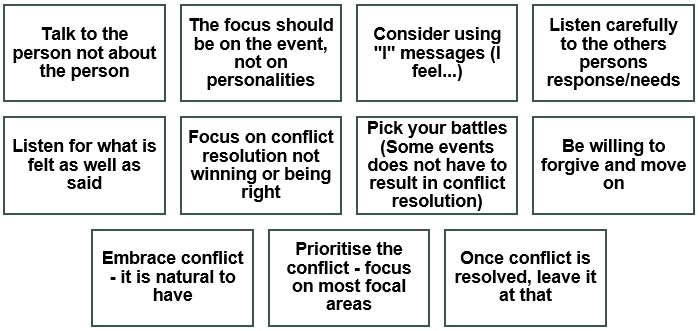CONFLICT MANAGEMENT
What is Conflict:
- an open clash between two opposing groups (or individuals)
- a disagreement or argument about something important
- a state of opposition between persons or ideas or interests
- opposition between two simultaneous but incompatible feelings
"An eye for an eye will only make the whole world blind" ~ Mahatma Gandhi
Is conflict good or bad?
According to the National Institute for Advanced Conflict Resolution, up to 30% of a typical leader’s time is spent dealing with conflict. Further research found that over 65% of work performance problems are due to strained relationships as a result of conflict. CEOs and senior vice presidents reported they spend up to 70% of their time on conflict. (OrgLeader, 2014).
As evident from the article above, conflict is natural and will be part of our everyday lives – even in our personal/relational lives. It is not wise to tag conflict as either good or bad, but rather to focus on how is the conflict currently being handled or was handled (Vandersteen, 2014).
Conflict is good when?
- Your perspective is broadened regarding the disagreement or struggle
- It brings positive change
- It strengthens relationships
- It leads to the creation of various solutions that one did not think of
- It brings understanding of one another through the sharing of ideas and different perspectives
Conflict is bad when?
- Relationships are ruined & there is long-term division
- It leaves emotional/psychological wounds
- One starts to bully the other into resolution of getting your own way
- It becomes the only manner in which you can communicate
- You intimidate/overpower/bully to get heard
Conflict Handling Strategies
Conflict resolution is considered as the best coping strategy that may reduce the conflict between two parties. Effective conflict resolution may bind two parties in a long-term relationship/friendship with positive feelings attached to it (Khan & Khan, 2018).
Kenneth W. Thomas and Ralph H. Kilmann in 1974 developed an assessment to determine an individual’s conflict handling style. The Thomas-Kilmann Conflict Mode Instrument (TKI) assesses an individual’s behaviour in conflict situations—that is, situations in which the concerns of two people appear to be incompatible.
In conflict situations, we can describe a person’s behaviour along two basic dimensions:
- Assertiveness, the extent to which the individual attempts to satisfy his or her own concerns
- Cooperativeness, the extent to which the individual attempts to satisfy the other person’s concerns
Individuals usually use one of these five (5) conflict handling strategies during conflict:

Conflict Style |
Description |
Competing |
|
Collaborating |
|
Compromising |
|
Avoiding |
|
Accommodating |
|
(Psychometrics.com, 2020; The participation Company, 2016)
Wheel of Choice
Sometimes it is difficult to make a decision on the spot. One can use a decision wheel to assist you in making an effective decision that will produce positive outcomes for all parties involved. You can make your own decision wheel or look at the options below:

Resolving Conflict
Here are a few tips to take into consideration when resolving conflict: (Blink, 2018; Kappel, 2017; Myatt, 2012; Segal, 2019)
Know your personal pitfalls when it comes to conflict. Every individual has certain things that triggers them, make sure you know yours so that you can be pro-active in dealing with them.
Additional Reading Material/Resources/Posters/Other Languages
Books to read:
- Confronting without offending by Deborah Pegues
- Introduction to Conflict Resolution: Discourses and Dynamics by Sara Cobb, Sarah Federman, Alison Castel
Online e-books
Click HERE for the Poster
Click HERE for the Podcast
YouTube Video
References
Blink.ucsd.edu. (2018). How to Handle Conflict in the Workplace. Retrieved from https://blink.ucsd.edu/HR/supervising/conflict/handle.html#
Kappel, M. (2017). 6 Strategies to Resolve Conflict at Work. Retrieved from https://www.entrepreneur.com/article/303617
Myatt, M. (2012). 5 Keys of Dealing with Workplace Conflict. Retrieved from https://www.forbes.com/sites/mikemyatt/2012/02/22/5-keys-to-dealing-with-workplace-conflict/#180d79621e95
Psychometrics.com. (2020). Conflict Management - Essential to Organizational Performance. Retrieved from https://www.psychometrics.com/assessments/thomas-kilmann-conflict-mode/
Orgleader.com. (2014). Is Conflict Good or Bad? Retrieved from https://www.orgleader.com/conflict-good-bad/
Segal, J. (2019). Conflict Resolution Skills. Retrieved from https://www.helpguide.org/articles/relationships-communication/conflict-resolution-skills.htm
The Participation Company. (2016). 5 Conflict Resolution Strategies We All Use. Retrieved https://theparticipationcompany.com/2016/06/5-conflict-resolution-strategies/
Vandersteen, S. (2014). The Good, the Bad, and the Ugly: Dealing With Conflict in the Workplace. Retrieved from https://glenora.net/the-good-the-bad-and-the-ugly-dealing-with-conflict-in-the-workplace/
Vocabulary.Com. (n.a). Definition of conflict. Retrieved from https://www.vocabulary.com/dictionary/conflict
Compiled by Juan-Ri Potgieter (Industrial Psychologist @Thuso1777, Potchefstroom Campus)
Updated June 2020

